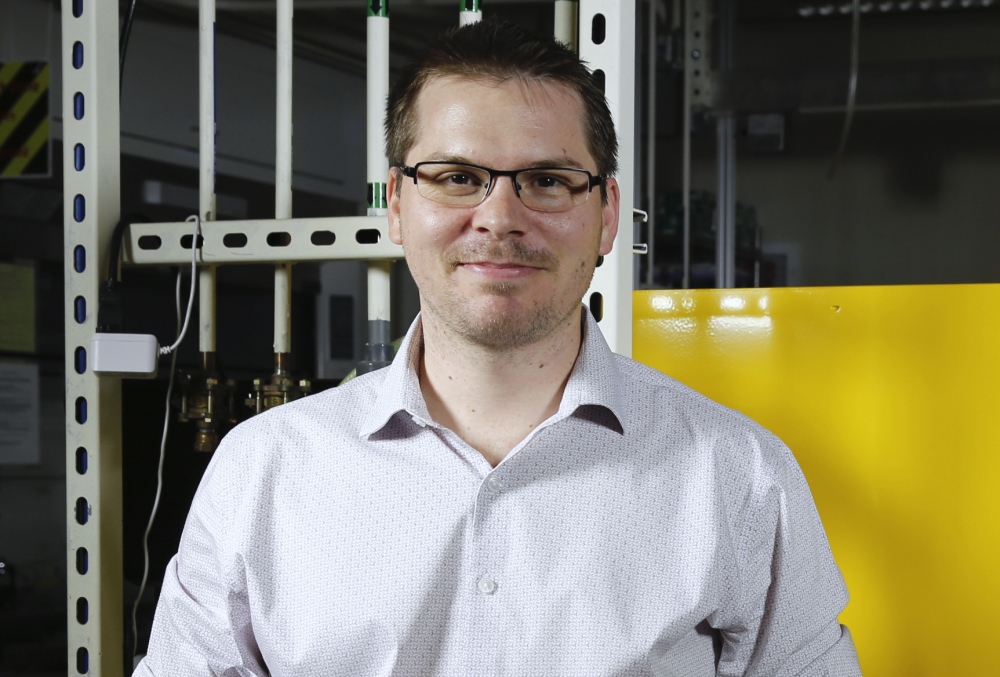
Fluid Dynamics
If you want to understand why coffee spills more frequently than beer (hint: it has to do with the physics of foam), ask Alban Sauret, an assistant professor in the Department of Mechanical Engineering at UC Santa Barbara.
Sauret also is a good person to consult on more serious matters involving fluid dynamics and soft matter, such as applying liquid coatings that impart unique properties to a surface in a way that minimizes costly rejects. Of his work with industrial collaborator Saint-Gobain, Sauret said, “I realized that processes involving multiple phases in thin films are often challenging and poorly controlled, which leads to product rejection and waste.”
That in turn led him to the focus of his current research, which involves understanding the complex dynamics at play in such systems. In recognition of his extensive and highly promising research in this area, Sauret has received a $500,000 Early CAREER award from the National Science Foundation for a project titled “Capillary flows of particulate suspensions.”
“It is an honor to receive this award, especially since many of my past advisors and mentors have also received CAREER awards,” said Sauret, who joined UC Santa Barbara a year ago. “It is also a credit to the many talented students I have worked with in France and here, since, in the end, most results are generated by our students. It’s exciting now to be able to continue this research with many new graduate and undergraduate students at UCSB.”
“I offer sincere congratulations to Alban Sauret on receiving this prestigious NSF Early CAREER award,” said Rod Alferness, dean of the College of Engineering. “He continues a strong and growing tradition of our stellar young faculty receiving national recognition. We look forward to his continued success on this project and on those he will pursue in the future.”
Understanding how a liquid coats a solid surface remains fundamentally challenging, and practical applications range from the aforementioned industrial coatings to surface contamination of liquids and transport in porous media, such as PVC tubing, which can become contaminated by liquid sludge flowing inside it.
“To improve the performance of coatings, particles are commonly suspended in them, whether deposited directly or sprayed as drops,” Sauret says. “The dynamics of the system, in which the thickness of a liquid film reflects the size of the particle, challenges our understanding. Indeed, the traditional approach to understanding suspension flows is no longer valid when an interface is involved, because the surface gives rise to capillary effects that affect the system.”
Sauret hopes his NSF-funded research will lead to a novel understanding of surface-tension phenomena in suspensions. “We want to understand how interfacial dynamics phenomena, such as the formation of water drops, thin films, or sprays, are modified by the presence of a second phase, such as solid particles, emulsion drops or microorganisms,” he says. “Because of the great complexity of multiphase flows, it is currently impossible to represent them numerically. We hope to develop new approaches to describe how particles affect the overall process.”
Manufacturing and coating are just two areas rife with processes that involve dipping some kind of object — a probe, a wire, a sheet of material — into a bath, removing it and then taking one of several actions, which may include dipping it into another container, testing the captured liquid (for pollutants, in one example), using the dipped object as a completed product, or sending it to the next step of a multi-stage manufacturing process.
“The product has to go from one sample to another without contaminating the whole thing,” said Sauret. Or, if the bath contains a coating, conditions have to be such that no dust or other materials from the bath are entrained, or captured, in the flow, resulting in a finish that is less than perfectly smooth.
In addition to improving process efficiency, Sauret hopes that the knowledge generated in this project will “bolster the development of new coating processes that leverage capillary effects,” adding, “The methods and models resulting from this work will be key in describing how a large range of heterogeneous fluids modify interfacial dynamics and will, therefore, be applicable to a wide range of scenarios.
“Being able to predict the size distribution of droplets generated by spray is very important, as evidenced currently by the importance of understanding the fate of aerosol droplets in transmitting the (novel) coronavirus,” Sauret said. “Our group hopes to refine current models of atomization as they relate to multiphase fluids and other complex fluids.”
In 2019, UC Santa Barbara had the highest percentage of eligible assistant professors receive NSF CAREER Awards in engineering and sciences among public universities. This year, the university is off to another solid start. “I think the collaborative environment at UCSB, the support we receive at the department and university levels, and the very high quality of both undergraduate and graduate students are important for everyone's success here,” said Sauret.
Previously, Sauret received a Regents’ Junior Faculty Fellowship and an American Chemical Society Petroleum Research Fund New Investigator Award, both in 2019; was included among a group of “Emerging Investigators” in a special themed issue of the journal Soft Matter in 2016; and received the prize for best Ph.D. research at Aix-Marseille University in 2014.
For more on Sauret’s research on capillary action and fluid dynamics, see the article “Take the Entrain.”



